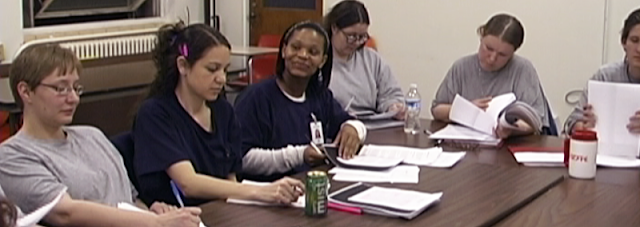 |
| The Grey Area: Feminism Behind Bars promotional still. |
Written by Leigh Kolb
With the success of the memoir-turned-Netflix-TV series Orange is the New Black, the feminist blogosphere has been abuzz with commentary and analysis. Besides looking at the show as an artifact within a vacuum, many feminists are taking this opportunity to think about incarceration–especially in the case of female prisoners. While the show is entertaining, the reality behind the fiction transcends one privileged woman’s memoir.
The 2012 documentary The Grey Area: Feminism Behind Bars examines the lives of a group of women in a maximum security prison in Mitchellville, Iowa. Filmmaker Noga Ashkenazi was part of Grinnell College’s Liberal Arts in Prison program in 2009 (her senior year).
Ashkenazi said,
“I wanted to make a documentary about my experience there because I had a feeling that teaching a feminism class at the women’s prison would be a good framework to talk about women’s issues in the criminal justice system in general and to bring the stories of these women to the public through this film.”
So she gathered footage, edited it, got funding, and released the film. And The Grey Area provides an excellent framework for discussing the oft-ignored issues surrounding incarcerated women.
The film opens with sobering facts: the number of incarcerated women in the US has grown 800 percent in the last three decades. Two-thirds of the women in prison are there for nonviolent crimes. Eighty percent of incarcerated women have a history of being victims of sexual assault and/or domestic abuse.
 |
| The documentary was filmed at the Iowa Correctional Institute for Women. |
The Grey Area presents the stories of inmates–their whole stories, not just their rap sheets–cut with interviews with prison officials and social workers and commentary from the three young female college students who are conducting the Grinnell course on feminism to the prisoners.
The interviews with and footage of the incarcerated women are incredibly moving. The nature of their crimes highlighted the title of the film–there are so many gray areas, yet our prison system only has settings for black and white. Toward the end of the film, the prison warden herself said that about 20 percent of the prisoners actually need to be there (she says the rest aren’t violent or a danger to their communities).
The way the women respond to the weekly classes on feminism (with topics such as motherhood, bodies, sexual assault and privilege) is poignant and insightful. When the class wraps up, the women are asked about the impact of feminism. They eagerly claim the title of feminist, and respond with comments on how talking about feminism has “empowered” them. More than one says that being in prison helped her identify as a feminist because she learned she didn’t need to depend on a man. One says, “Our lives are posters for what not living in a feminist society can do.”
 |
| These women’s stories were highlighted throughout the documentary. |
The Grey Area isn’t simply a snapshot of the college course on feminism. While the college students have insightful things to say, the real excellence in this film lies within the prisoners’ stories and the professionals’ commentary. Ashkenazi did an excellent job of gathering and editing footage to create and sustain suspense and elicit an emotional response from her audience. The parole hearings and anxious hopes for commutations were nerve-wracking and sometimes heartbreaking. The follow-ups with the inmates are uplifting and devastating.
Toward the end of the film, you learn how many commutations Iowa’s governors have granted in the last 30 years, and you feel as if you’ve been punched in the stomach.
The Grey Area tackles a subject that we all too often ignore and forces us to face the fact that justice is neither blind nor black and white. Cycles of abuse, sexual assault, poverty, objectification and social injustice are all feminist issues, and are all under a microscope in America’s prison systems. It’s our job now to have the conversations and work to effect change. Documentaries like The Grey Area provide a clear, in-depth context for having conversations beyond what happened on this season of Orange is the New Black.
The Grey Area: Feminism Behind Bars is a selection from Women Make Movies, an organization that “facilitates the production, promotion, distribution and exhibition of independent films and videotapes by and about women.”
______________________________________________
Leigh Kolb is a composition, literature and journalism instructor at a community college in rural Missouri.
